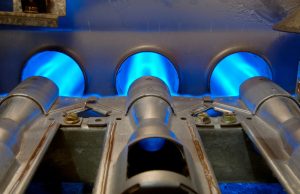How does a furnace work? Well, part of what it’s doing is all about generating heat. But it can’t just do that willy-nilly. It also has to keep you safe! That means things like not overheating, properly venting exhaust, and perhaps most importantly, protecting you and your family from carbon monoxide.
There’s nothing more important to us than keeping our friends and neighbors safe and well, so please, read this quick reminder about winter HVAC safety in West Monroe, LA. You’ll learn what your furnace’s heat exchanger does, how to make sure it’s working, and how to stay safe this winter.
Gas Furnace Combustion
To create the heat that warms your home, a gas furnace must burn fuel, which produces both heat and exhaust. The exhaust contains a variety of substances: water vapor, sulfur dioxide, nitrogen oxides, nitrogen, and carbon dioxide. But the truly worrisome component is the carbon monoxide.
Carbon monoxide, when inhaled, bonds with the hemoglobin cells in a person’s blood. This fills the slot, so to speak, that would otherwise be occupied by oxygen. In effect, it makes it so no matter how much you breathe, you’ll be unable to oxygenate your blood, so you will essentially start to suffocate. This can be fatal.
Keeping Combustion Gasses Contained
Your furnace’s heat exchanger is where the combustion gasses go as soon as they are created by your furnace’s burners. This component is a clam-shaped metal container with a very large amount of surface area. That means clean air can pass very close to a lot of hot metal surfaces. That now-heated clean air enters your ductwork, but the gasses stay inside the heat exchanger until they are vented away from your home.
The Risk of Heat Exchanger Cracks
As you can see, the role of the heat exchanger is extremely important. At the same time, this component is under a lot of stress. Constantly being filled with hot combustion gasses and then cooling off, over and over again, means a great deal of expansion and contraction for the metal. This can make it brittle over time, and even allow cracks to occur.
Staying Safe with Your Heat Exchanger
There are three things you need to do that will allow your heat exchanger to carry on keeping you safe for the long term. The first is maintenance. Every year, when your HVAC technician comes to give your furnace a check-up, they’ll inspect the heat exchanger and let you know if there’s any need for concern. The second is keeping your carbon monoxide detectors in good working condition.
The third thing is knowing the signs of a cracked heat exchanger so you can call for prompt repairs as soon as you spot a problem. Moisture or soot in the furnace cabinet, a flame that flickers or burns any color that’s not blue, or a clicking sound while the furnace cools down are the key signs to be aware of. Keep safe and well, and let us know if you need our help!
Contact Mike Smith Heating & Air Conditioning, LLC. We provide “Professional grade service.”

